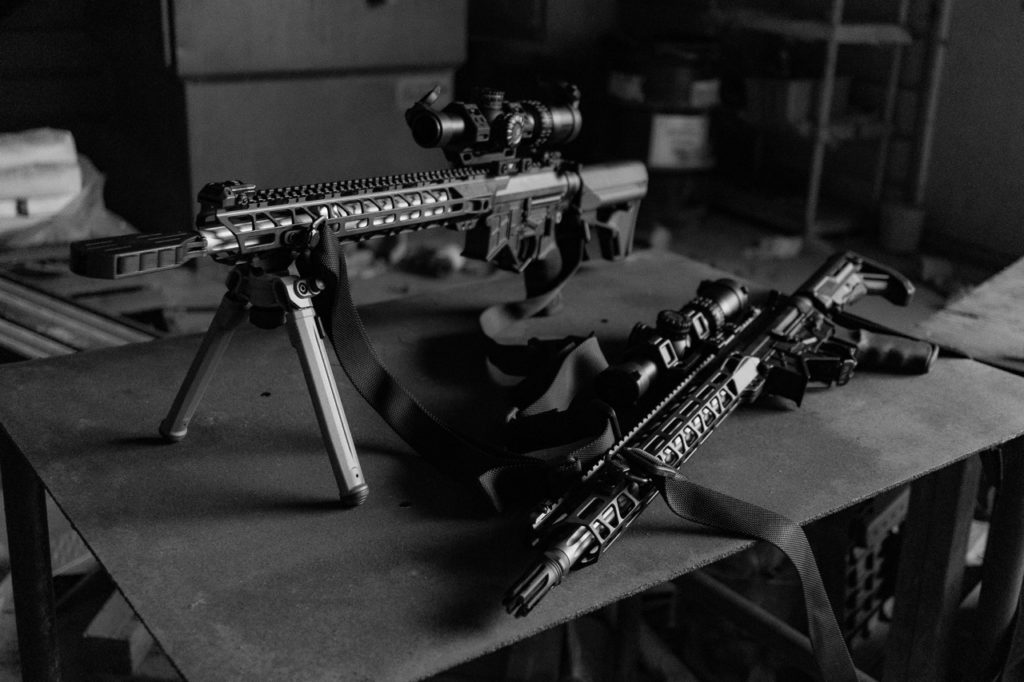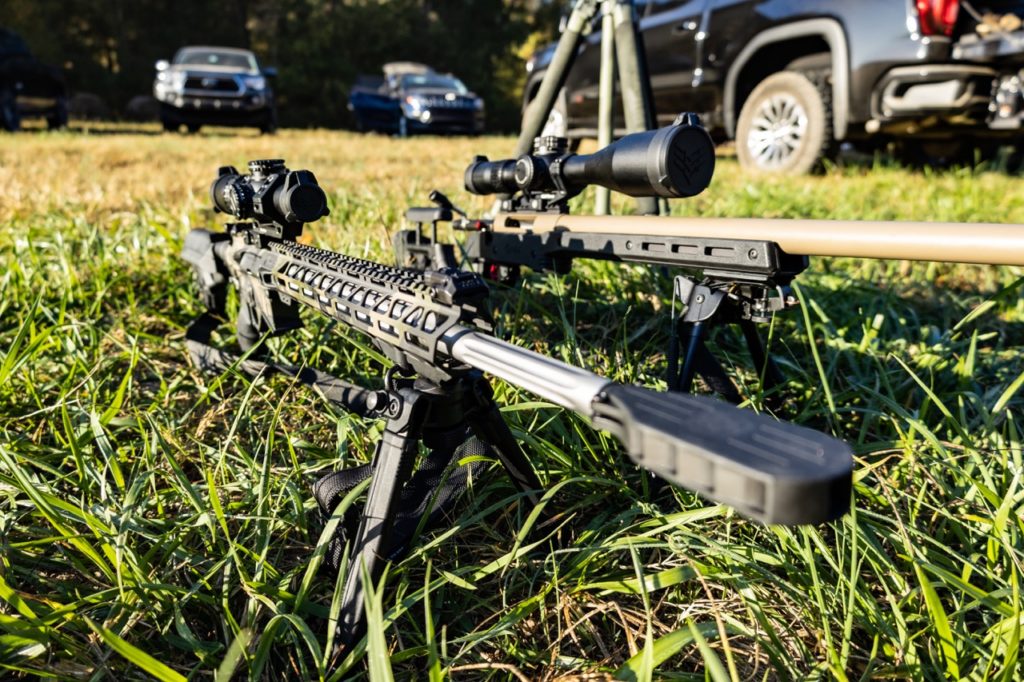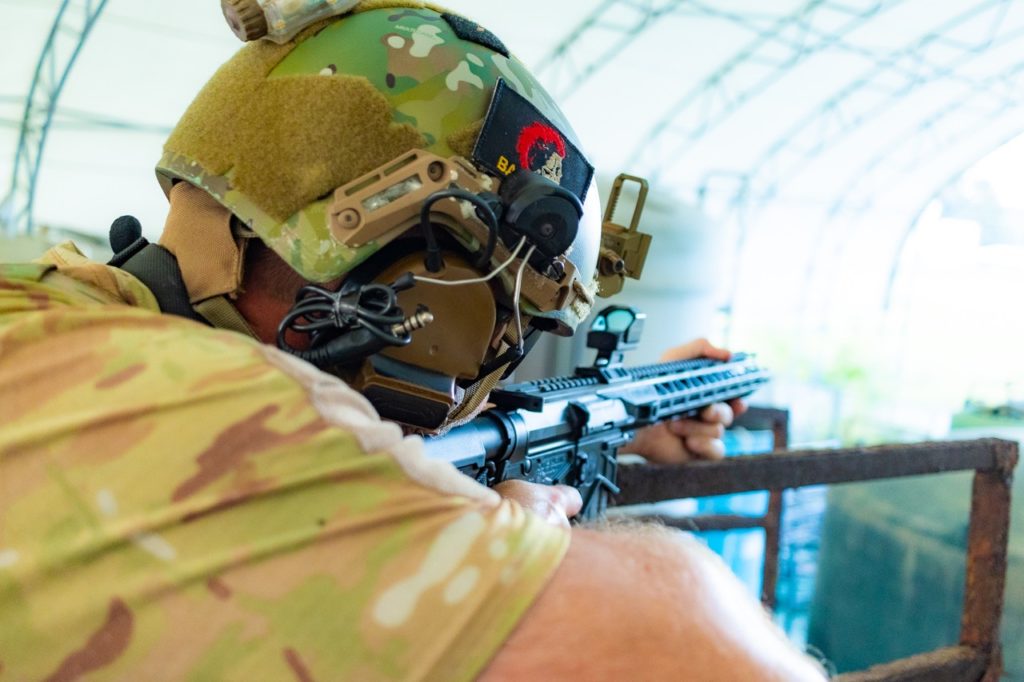
If there ever was a part of the AR-15 rifle that was grossly misunderstood, it has to be the muzzle device, be it a muzzle brake or a flash hider. The muzzle device has been maligned to the point of being outright banned in some jurisdictions, with some versions tightly restricted by the Federal Government.
What is a Flash Hider?
A flash hider or suppressor is a muzzle device which attaches to the end of a rifle barrel. Most flash hiders are threaded in place, but some may be attached via set screws if the barrel is not threaded. The purpose of a flash suppressor is to divert the flash signature of a high velocity rifle round so as not to disrupt the shooter’s night vision. Some flash suppressors can hide the visible flash from an observer or redirect, distort or even amplify sound signature, but this was not the primary intent of the design. Flash from a rifle has much to do with ammunition design and barrel length. In a shorter barrel, not as much powder will burn and the unburned powder behind the projectile is displayed as flash.
AR-15 Flash Hider: History
Flash hiders have been an integral part of the AR-15 rifle design since the rifle’s inception. The earliest design was a three-pronged device that was notoriously weak in its construction. This device was prone to breakage, got hung up on brush and caused rifle barrels to bend or otherwise warp when soldiers used it as a wire cutter or prying tool.
The US Military asked for a replacement with a closed end and received one which was unofficially known as the “birdcage design”. This device was a 1 3/4 inch cylindrical affair with 6 longitudinal flutes that made it resemble a bird cage. Overall, it was a huge improvement over the three-pronged device. However, the AR-15 and M-16 rifles were becoming hugely popular in the 1960s and experimentation and improvement was underway on how to make the rifle better.
One of these efforts was an outgrowth of a carbine version of the M16A1 service rifle. A military version, billed as a submachine gun, was created in the 1960’s and known as the XM177E2. In addition to a collapsible stock, 10 inch shorter barrel and shorter pistol grip, a flash suppressor was developed. This flash hider needed to be highly functional, as lab reports claimed a flame of unburnt powder 36 inch long emanated from the barrel of this carbine. This flash suppressor was 4.5 inches long and was officially known as a moderator. In addition to suppressing visible flash, this multipurpose device was capable of launching rifle grenades and distorted the sound of the carbine so that it sounded more like a 20 inch barreled M16A1. For this reason, the Bureau of Alcohol, Tobacco, Firearms and Explosives declared the device to be a sound suppressor (silencer) in the 1970s and ownership of a flash hider in the United States began to require a $200 NFA (National Firearms Act) Tax Stamp.
In the 1980s, as the military was writing requirements for the M16A2 service rifle, a change was made to the birdcage style of flash hider. Competitive Marine Corp shooters complained of the bottom flute in the flash hider as a culprit in kicking up dust or snow when fired from the prone position. The bottom flute was no longer cut into the birdcage flash suppressor, the dust went away and the “A2 flash suppressor” was born. In USMC parlance, this part became known as a “compensator” as the sealed flute aided in another role by keeping the barrel from rising under recoil. Most official military manuals still refer to the part as such, but some other entities in the US government did not seem to care.
The Federal Assault Weapon Ban of 1994
Experimental designs came and went over the next few years, including designs based on the flash suppressor found on the Soviet AK74US carbine, but none seemed to take off until 1994. In that year, the US Congress and President Bill Clinton passed an Assault Weapon Ban, which banned rifles, pistols and shotguns based on appearance and certain parts. One of these parts was the flash suppressor. If one good thing came out of this now expired law, it was the benefit of muzzle brakes for rifle shooters.
AR-15 Muzzle Brakes

To improve the performance of AR-15 rifles in the civilian shooting realm, manufacturers developed muzzle brakes, compensators and look-alike flash suppressors that utilized round holes instead of flutes or, in some cases, curved restrictor plates. Marketed as muzzle brakes, these devices directed escaping gasses to the sides of the shooter and eliminated the “dust up” problem found with other flash hiders. Most innovations put the focus of the design on improving performance and accuracy as well as softening recoil.
One of the finest brakes on the market today is the M-905 Talon muzzle brake from U.S. Arms Company. Previously only available to US Special Forces sniper teams, this patented brake utilizes an aerospace proven design to effectively reduce recoil 94%.
AR-15 Flash Hiders: 2004 and Beyond
A few years prior to the expiration of the Assault Weapon Ban, some development was made in the realm of flash suppressors as the US Military engaged in the Global War on Terror in Iraq and Afghanistan. The first of these designs contained slits that were cut wider and the edges were scalloped to aid in using the muzzle in close combat with an opponent. A flash suppressor with external threads to accommodate a sound suppressor known as Quick Detach Suppressor Mounts soon followed. Another popular design emerged and is reminiscent of the original “three-prong flash hider”, except there are four solid pieces which are closer together and form more of a swirl. From all accounts it is extremely effective in reducing flash signature and aids in accuracy.
Perhaps the most unusual design was based on a flash suppressor found on the Soviet Krinkov short-barreled rifle. This large cup shaped device redirects the flash and recoil forward instead of up or to the sides and is mostly intended for use on short-barreled rifles less than 16” in length.
Sound Suppressors

The sound suppressor may be the ultimate flash suppressor in that it hides sound as well as muzzle flash. Sound suppressors have been tightly controlled by the BATFE since passage of the National Firearms Act in 1934. To own a sound suppressor, an individual must complete an application with BATFE and pay $200 for a tax stamp. However, this created an unusual track for choosing between a muzzle brake and a flash hider.
Most of the tactically minded crowd went toward the flash hider early on. As quick detach (QD) silencer mounts started to gain in popularity over the older direct thread style; some of these mounts were based on flash suppressors, while others were based on muzzle brakes. The advantage here was that a shooter could mount the silencer over the muzzle brake or flash hider without having to retime the muzzle device when the silencer was not in use.
It was soon discovered that the shape and design of most muzzle brakes followed the same shape or contour of the baffles within the silencer. When a round was fired through the brake the initial brunt of the rifle’s blast in the form of hot gasses and burning powder would actually be absorbed by the steel muzzle brake as opposed to the more expensive and less durable material of the baffles that were titanium, aluminum, stellite, Inconel, or stainless steel. This would prolong the working life of the silencer.
This phenomenon is more common when using sub-16-inch barrels on short barreled rifles (SBRs) and pistol length barrels. The shorter the barrel, the more unburnt powder and more blast is present. For these reasons, it’s quickly becoming apparent that the muzzle brake design is superior to the flash suppressor in many ways. As a silencer mount, it protects your precious baffles but on its own it will help make you a more accurate shooter.
The M-905 Talon Muzzle Brake
The M-905 Talon muzzle brake offers a patented design with a proven track record of excellent performance. When installed properly, the M-905 can decrease recoil by 94 percent. Tests included a range of calibers from small .223 caliber to larger caliber rounds like .50 caliber ammunition. The M-905 Talon is available for the .223 caliber M4-UTAW Champion, Pro, and entry series rifles. The benefits of adding an M-905 Talon include:
Near elimination of muzzle rise. Keep your barrel on target for quick re-targeting and faster follow-up shots.
Decrease recoil by upwards of 94%. With less recoil, accuracy improves as will the time needed between shots.
Increased engagement between shooter and target. Thanks to a decrease in recoil and the elimination of bounce and wobble, the shooter can remain focused on their target and remain engaged in the situation.
Works with both bolt and gas guns and helps decrease the time between firing one round and the next.
Improved confidence. Shooters who anticipated a heavy recoil may form bad habits around firing the gun. With the softer recoil and the added barrel stability that the M-905 Talon offers, shooters can relax and enjoy firing the rifle in short or long range shooting.
Quality construction and the patented design make the US Arms M-905 Talon the best muzzle brake around. It is constructed to offer lifetime use which adds value to the unit. If you are considering an AR-15 Muzzle Brake, be sure to check out the M-905 Talon as your top option for your AR-15. With a drop in recoil of 94 percent and the improvement in accuracy, shooting your M-905 Talon-equipped AR-15 will get a lot easier and more comfortable.
